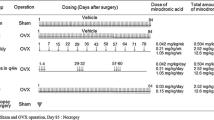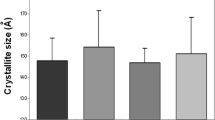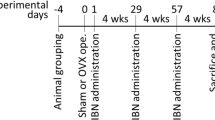Abstract
We have previously found that a short-term treatment with high doses of ipriflavone increased bone density and improved the biomechanical properties of adult male rat bones, without altering their mineral composition. To determine whether this effect can be associated with alterations of bone crystal structure, we have performed X-ray diffraction analysis of bones obtained from rats treated with ipriflavone at doses that were effective in inducing favorable changes on bone density and biomechanics. Eighteen-week-old male Sprague Dawley rats were treated by oral route with either ipriflavone (200 or 400 mg/kg/day), or its vehicle for 12 weeks. The treatment was well tolerated and body weight increased to the same extent in all animals. As a measure of bone crystallinity, we examined the (310) and (002) reflections of the X-ray diffraction patterns, corresponding to the directions perpendicular and parallel to the c-axis of the crystals, respectively. No major differences were observed between ipriflavone-treated and control animals for the broadening parameter β1/2 for (310) and (002) peaks, as well as for lattice parameters. Therefore, a 12-week treatment with ipriflavone at high doses does not induce significant modifications of bone “crystallinity.” Thus. the positive effect of ipriflavone on bone mineral density appears to be associated with an increased apatite crystal formation rather than an increase of crystal size. These results provide further evidence for the safety and usefulness of ipriflavone in the treatment of osteoporotic syndromes.
Similar content being viewed by others
References
Burnell JM, Teubner EJ, Miller AG (1980) Normal maturational changes in bone matrix, mineral, and crystal size in the rat. Calcif Tissue Int 31:13–19
Posner AS (1969) Crystal chemistry of bone mineral. Physiol Rev 49:760–792
Termine JD, Eanes ED (1972) Comparative chemistry of amorphous and apatitic calcium phosphate preparations. Calcif Tissue Res 10:171–197
Eanes ED, Reddi AH (1979) The effect of fluoride on bone mineral appatite. Metab Bone Dis Rel Res 2:3–10
Grynpas MD (1995) Fluoride effects on bone crystals. J Bone Miner Res 5:S169-S175
Shinoda H, Adamek G, Felix R, Fleisch H, Schnek R, Hagan P (1983) Structure-activity relationship of various bisphosphonates. Calcif Tissue Int 35:87–99
Fleisch H, Russell RGG, Bisaz S, Mühlbauer RC, Williams DA (1970) The inhibitory effect of phosphanates on the formation of calcium phosphate crystals in vitro and on aortic and kidney calcification in vivo. Eur J Clin Invest 1:12–18
Fleisch H (1991) Bisphosphonates: pharmacology and use in the treatment of tumour-induced hypercalcaemic and metastatic bone diseases. Drugs 42:919–944
Yamazaki I, Shino A, Shimizu Y, Tsukuda R, Shirakawa Y, Kinoshita M (1986) Effect of ipriflavone on glucocorticoidinduced osteoporosis in rats. Life Sci 38:951–958
Foldes I, Rapcsak M, Szoor A, Gyarmati J, Szilagy T (1988) The effect of ipriflavone treatment on osteoporosis induced by immobilization. Acta Morphol Hung 36:79–93
Shino A, Matsuo T, Tsuda M, Yamazaki I, Tsukuda R, Kitazaki T, Shiota K, Okada H, Yoshida K (1986) Effect of ipriflavone on bone and mineral metabolism in the streptozotocin diabetic rats. J Bone Miner Metab 3:27–37
Agnusdei D, Bufalino L, Gennari C (1993) Effects of ipriflavone on bone mass and bone turnover in postmenopausal women with low bone mass. In: Christiansen C, Riis BJ (eds) Proceedings 1993: IV International Symposium on Osteoporosis. Handelstrykkeriet, Aalborg, Denmark, pp 467–470
Passeri M, Abate G, Costi D, Biondi M, Di Peppe C, Bufalino L, Castiglione GN (1993) Ipriflavone in the treatment of established postmenopausal osteoporosis. In: Christiansen C, Riis BJ (eds) Proceedings 1993: IV International Symposium on Osteoporosis. Handelstrykkeriet, Aalborg, Denmark, pp 463–466
Gambaciani M, Spinetti A, Cappagli B, Taponeco F, Felipetto R, Parrini D, Cappelli N, Fioretti P (1993) Effects of ipriflavone administration on bone mass and metabolism in ovariectomized women. J Endocrinol Invest 16:333–337
Brandi ML (1992) Flavonoids: biochemical effects and therapeutic applications. Bone Miner 19:S3-S14
Brandi ML, Gennari C (1993) Ipriflavone: new insights into its mechanisms of action on bone remodeling (letter). Calcif Tissue Int 52:151–152
Civitelli R, Abbassi-Jahromi SA, Halstead LR, Dimarogonas AD (1995) Ipriflavone improves bone density and biomechanical properties of adult male rat bones. Calcif Tissue Int 56:215–219
Weiner S, Price PA (1986) Disaggregation of bone into crystals. Calcif Tissue Int 39:365–379
Termine JD, Eanes ED, Greenfield DJ, Nylen MU (1973) Hydrazine-deproteinated bone mineral. Calcif Tissue Res 12:73–90
Riggs BL, Hodgson SF, O'Fallon WM, Chao EYS, Wahner HW, Muhs JM, Cedel SL, Melton LJ III (1990) Effect of fluoride on the fracture rate in postmenopausal women with osteoporosis. N. Engl J Med 322:802–809
Pak CYC, Sakhaee K, Zerwekh JE, Parcel C, Peterson R, Johnson K (1989) Safe and effective treatment of osteoporosis with intermittent slow release sodium fluoride: augmentation of vertebral bone mass and inhibition of fractures. J Clin Endocrinol Metab 68:150–159
Zipkin I, Posner AS, Eanes ED (1962) The effect of fluoride on the X-ray-diffraction pattern of the apatite of human bone. Biochim Biophys Acta 59:255–258
Schraer H, Posner AS, Schraer R, Zipkin J (1962) Effect of fluoride on bone “crystallinity” in the growing rat. Biochim Biophys Acta 64:565–567
Grynpas MD, Acito A, Dimitriu M, Metz BP, Very JM (1992) Changes in bone mineralization, architecture and mechanical properties due to long-term (1 year) administration of pamidronate (APD) to adult dogs. Osteoporosis Int 2:74–81
Author information
Authors and Affiliations
Rights and permissions
About this article
Cite this article
Ghezzo, C., Civitelli, R., Cadel, S. et al. Ipriflavone does not alter bone apatite crystal structure in adult male rats. Calcif Tissue Int 59, 496–499 (1996). https://doi.org/10.1007/BF00369217
Received:
Accepted:
Issue Date:
DOI: https://doi.org/10.1007/BF00369217




